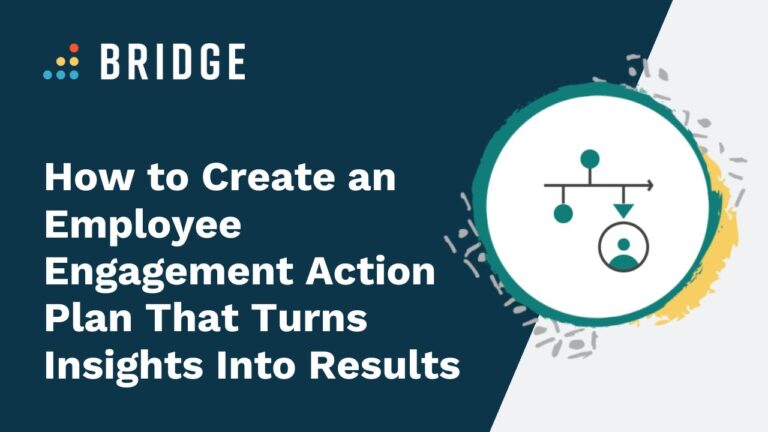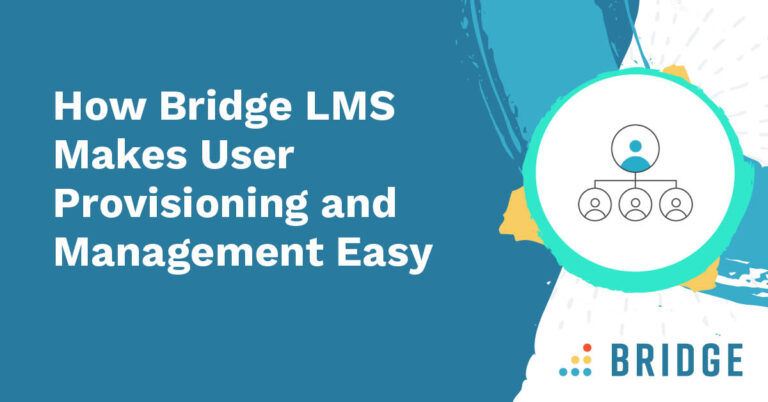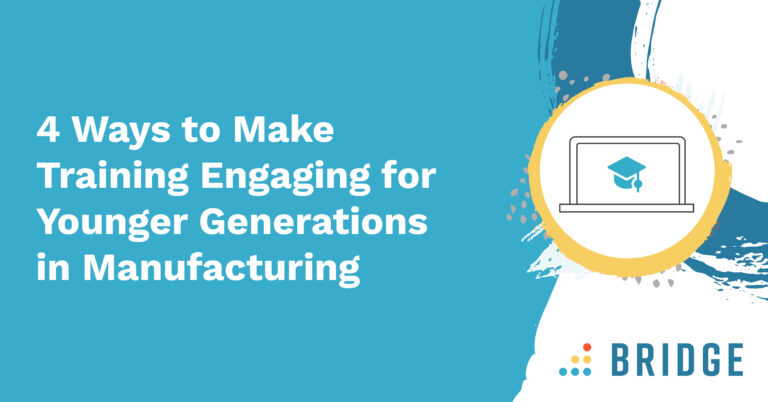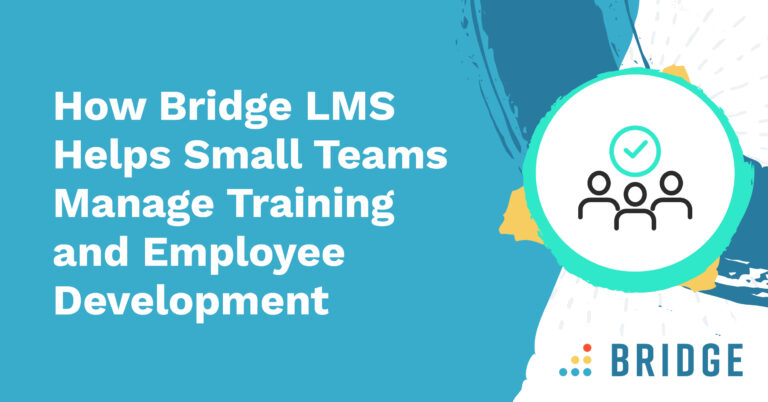Sustaining and improving employee engagement requires that you commit to creating a culture where your people feel safe to voice their opinions.
Research conducted by The Workforce Institute shows that 75% of employees don’t feel that their employer listens to their opinion in the areas that matter most to them (such as wellbeing), and 40% don’t believe that their feedback leads to any actionable change.
To create and maintain an environment in which everyone feels they’ll be heard, and one that’s also capable of driving positive change, you’ll need to create an employee engagement action plan.
What Is an Employee Engagement Action Plan?
An employee engagement action plan is a roadmap to identify and understand employee sentiment, then respond with strategic initiatives, and enact the changes that create positive results.
With a set of measurable goals and actions in place, your organization can effectively monitor and track changes over time to act upon employee feedback and sustain engagement.
Your plan should outline the methods for measuring engagement, the strategies and measures to identify and overcome challenges, and the goals and metrics that will enable you to monitor improvements.
6 Steps to Creating an Employee Engagement Action Plan
Include these six steps in your plan to create a lasting impact:
1) Define Your Engagement Goals and Priorities
Establishing clear and measurable goals through employee engagement analytics leads to specific and actionable data. Your engagement goals should account for what employees value and must also align with your business goals.
Look at previous survey performance and industry averages to inform your priorities, set a baseline for your engagement in each target area, and define how you’ll measure success.
While data can help you uncover trends and measure whether your initiatives are moving the needle, don’t neglect qualitative information. This can be particularly useful in providing context that informs aspects of the employee experience, such as learner feedback and performance conversations.
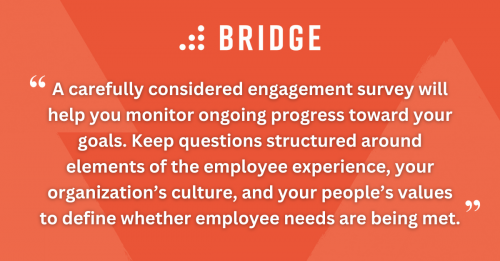
FIND OUT MORE ABOUT PRODUCTIVE GOAL SETTING | ‘What Are SMARTER Goals and How Do They Help Measure Employee Productivity?’
2) Conduct an Employee Engagement Survey
A carefully considered employee engagement survey will help you monitor ongoing progress toward your goals. Keep questions structured around elements of the employee experience, your organization’s culture, and your people’s values to define whether employee needs are being met.
Engagement survey topics will vary depending on business goals and needs, but they should broadly address and measure employee satisfaction, alignment with organizational goals, and aspects of workplace culture.
Make sure surveys are concise and to the point to avoid overwhelming employees and ensure a high response rate. To encourage honest feedback and talking points, incorporate neutral questions and use outline statements so people can assign a score.
Examples of engagement survey questions include:
- To what extent do you agree with the statement: “I have access to the equipment and tools I need to do my job well.”
- How would you rate your work-life balance?
- What is your preferred method for receiving feedback?
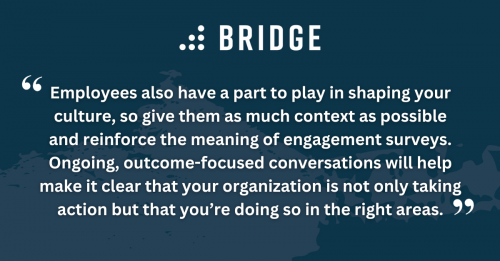
EXPLORE MORE ENGAGEMENT SURVEY BEST PRACTICES | ‘Listen, Learn, and Act: 7 Ways to Make the Most Out of Employee Engagement Surveys’
3) Analyze and Distribute Employee Engagement Survey Data
Once you’ve run the survey, you’ll need to pull the data together, assess the results, and identify the areas to address in order to define your next steps.
Data visualizations and intuitive results dashboards can bring your data to life and show the priority areas to target as part of your action plan. An integrated LMS that connects performance, skills, and engagement data will allow you to create a more rounded view of trends, focus areas, and the support employees need.
Get granular to unearth any trends in the data and understand the sentiment behind comments. This way, you can filter information and assign stakeholders to relevant actions that impact their team and department. Share feedback and results, and outline the next steps with all stakeholders who can measure and enact change throughout your organization, such as managers and leaders.
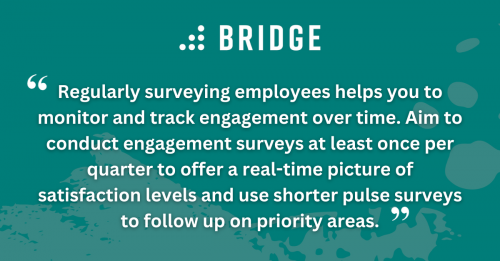
DISCOVER MORE METRICS TO MEASURE ENGAGEMENT | ‘3 Employee Engagement Ideas for Remote Workers’
4) Share the Findings and Next Steps With Employees
With a clear plan of action in place, inform employees about the nature of the feedback you’ve received—alongside the steps you’ll be taking to address priority areas. Employees also have a part to play in shaping your culture, so it’s worth giving them as much context as possible and reinforcing the meaning of surveys.
Ongoing, outcome-focused conversations will help make it clear that your organization is not only taking action but that you’re doing so in the right areas. Microsoft survey data shows just how important this communication can be—when employees feel their company uses feedback to drive change, they’re more satisfied (90% vs. 69%) and more engaged (89% vs. 73%).
Discuss the key action points with people and keep them updated on the progress of changes. Ongoing communication shows people that they matter, whether it’s via large-scale company-wide communication, such as a video from managers thanking employees for completing surveys or smaller team meetings for managers and department heads to discuss updates and findings.
RELATED READING | ‘How to Boost Employee Wellbeing in the Workplace’
5) Continuously Measure and Improve the Results
Regularly surveying employees helps you to monitor and track engagement over time. Aim to conduct engagement surveys at least once per quarter to offer a real-time picture of satisfaction levels.
An effective employee engagement strategy should include multiple touchpoints to inspire two-way dialogue. Use shorter pulse surveys to follow up on priority areas and keep the momentum going.
It’s also worth conducting regular stay interviews to gauge employee sentiment and satisfaction. Unlike exit interviews, stay interviews focus on what makes current employees stay and what might tempt them to leave. These conversations can help you address any issues that might impact engagement and preempt the causes of turnover.
Additionally, use LMS quizzes to gather information about whether learning programs are effective, engaging, and aligned with employee goals.
BEST PRACTICES FOR PRODUCTIVE STAY INTERVIEWS | ‘How Can Smart Stay Interview Question Selections Boost Employee Retention?’
6) Connect Employee Engagement Results to Organizational Performance
Once you’ve established the ongoing measurement of employee engagement in your organization, you should circle back to monitor and demonstrate how engagement is driving your organizational metrics.
Aligning employee engagement outcomes with business objectives and strategies builds consistent, long-term success and makes it easier to discern the impact your efforts have had in any given area.
Uncover the Strategies That Strengthen Employee Engagement
Download our ebook, ‘The Powerful Link Between Learning and Employee Engagement’, to uncover actionable approaches to engagement that enhance the employee experience with L&D.
